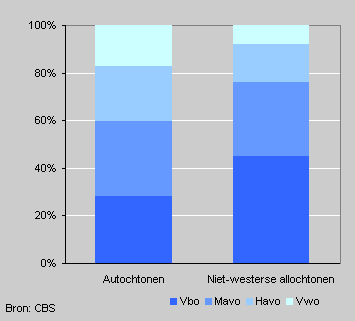Many non-western ethnic students continue their studies

There are relatively many non-western students in VBO or MAVO. (These are the first stage secondary vocational, and first stage secondary general school types respectively). In contrast to the native students, the non-western ethnic students often continue their education after graduation.
More non-western students
In the school year 2001/’02 there were 159 thousand students who sat their final exams in secondary education. The figure includes 21 thousand students of non-western origin, or 13.1 percent. Four years ago they constituted 11.5 percent of the student population in secondary education.
More non-western students in VBO
There are relatively many non-western students in VBO. In the school year 2001/’02 about 76 percent of the non-western exam candidates sat VBO or MAVO exams, versus 59 percent of native students.
Candidates sitting final exams by ethnic background, 2002

More graduates
In the last four years the percentage of graduates increased slightly in all school types, both for foreign and native students. However, the percentage of graduates among non-western students remains slightly lower.
Graduation percentages by ethnic origin

Continued studies
After graduation most students opt to continue their studies directly. The non-western students have higher percentages of outflow to next level of education than native students. Non-western students who just graduated from VWO (second level general secondary school) more often select to go on with a university education than native students. They also continue more often in vocational training (BOL) after their VBO or MAVO diploma, although they may select the BBL variant with on the job training, or part-time BOL more often.
Suzan van der Aart